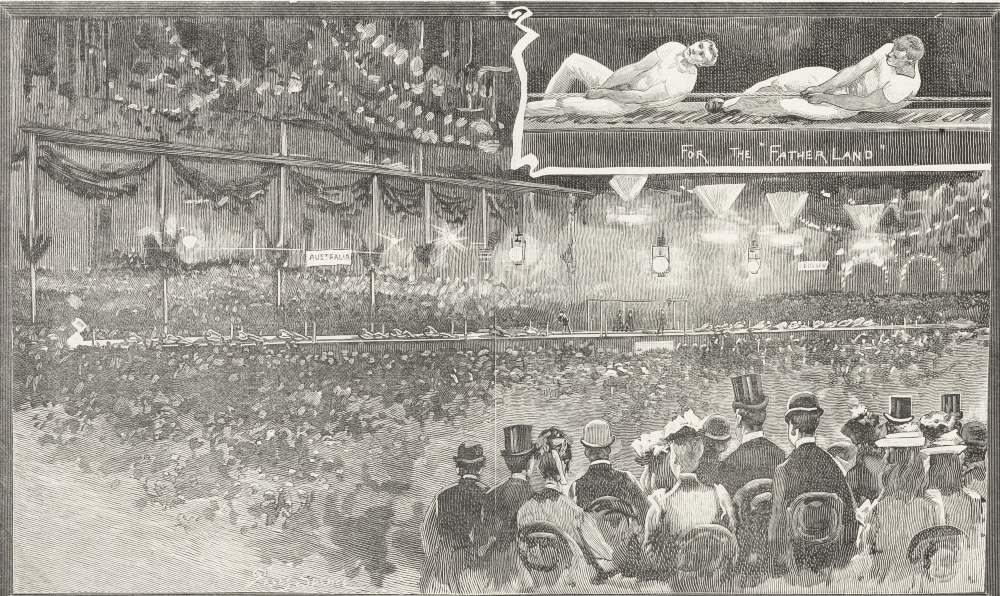
The Tug-of-War at the Darlinghurst Hall', 1892
A tug-of-war competition at the former Darlinghurst Skating Rink in The Sydney Mail and New South Wales Advertiser, 20 February 1892, 419, National Library of Australia, [Trove]
‘Scenes of the wildest disorder’
On a summer’s night in February 1893 a contest between Sydney’s Albert Griffiths aka ‘Young Griffo’ and Jerry Marshall, an African-American boxer, descended into chaos. ‘Larrikins’ or members of a ‘push’ gang from Sydney’s The Rocks, of which it was rumoured Griffo headed, stormed the Australian Athletic Club in Darlinghurst.
Unhappy with the prospect of their ‘king’ losing the contest, they scaled the walls, smashed chairs and damaged the floors. Marshall’s supporters were unhappy with the referee’s call to award the match to Griffo on a foul. They too climbed into the ring and ’engaged in a free fight’ with the other side, using chair legs as weapons while police watched on, ‘powerless to keep order’.1
In 1958 a Mr O W Coleborne recalled living on Burton Street in the early 1890s. He was ‘within a stone’s-throw’ of the ‘architectural wonder’ of the former skating rink. He recalled manipulating a small sheet of corrugated iron to sneak into the premises with a friend and getting caught and kicked out on that fateful night.
He later joined the crowd in the club’s adjoining paddock and heard the ‘din and strife’ of the boxing contest between ‘Young Griffo’ and Jerry Marshall. He witnessed scenes of the ‘wildest disorder’ and ‘pandemonium’, when the match went awry.2
Sydney’s Referee newspaper also published recollections of boxer and actor, Joseph Thomal (content warning: the article contains racist language and imagery). Thomal was born in Somaliland in the Horn of Africa in the late 1870s and came to Sydney as a teenager in the early 1890s. His account hinted that the brawl was partly sparked by racial tensions. Thomal recalled the night Griffo fought Marshall, he was ‘one of the many who failed to gain admittance to the overcrowded arena’. He was quoted as saying:
Griffo was in no condition to fight, and after a few rounds, his faithful henchmen of the Rocks push rushed the ring.
When the storm broke inside I was in the front rank of the eager crowd milling round in the street.
Suddenly the doors were flung open, and a big blackfellow rushed out. He sighted me and yelled, “Run…the Rocks push is out for our blood this night”….3
This ‘disgraceful’ spectacle, along with the deaths of two young boxers in separate incidents, spelled the end of glove-fighting in Sydney as well as the demise of the Australian Athletic Club.
By May 1893 the premises had been ‘freshly repaired and decorated, and the floor practically relaid’ for the resurrection of the Darlinghurst Skating Rink. The rink had a short season before it was used as a wool store from late 1893.4
On 8 August 1899, Baldwin Brothers commenced the process of dismantling the former Darlinghurst Skating Rink to make way for the construction of 44 houses. By September, the roof and internal wooden pillars had been removed, and workers were erecting a hoarding around the Liverpool Street end of the site in order to ‘make a start in the breaking down of the walls’.5
It appears the firm of Backhouse and Backhouse, the same engaged to design the rink in the first place, were commissioned for the 44 houses. By January 1900, 16 houses fronting Forbes Street had their brickwork completed and were ready for roofing, and the foundations of another block of 10 houses fronting Thomson Street were laid.6 The ‘architectural wonder’ had disappeared.
Read the next story: Mr and Mrs Booth’s Hydropathic Baths.
‘Boxing and Barbarism’, The Scone Advocate, 3 March 1893, 3, http://nla.gov.au/nla.news-article161608596 and ‘Boxing’, Barrier Miner, 1 March 1893, 2, http://nla.gov.au/nla.news-article44108704. ↩︎
O W Coleborne, The Bulletin 79, no. 4071, 19 February 1958, 9, http://nla.gov.au/nla.obj-695330899. ↩︎
‘From Slave Gangs to Prize-ring Fame’, Referee, 7 January 1931, 1, http://nla.gov.au/nla.news-article136749412. Content warning: this article contains racist language and imagery. As a result, the words of Joseph Thomal only have been reproduced here, as opposed to any editorial content. ↩︎
‘Amusements’, The Daily Telegraph, 6 May 1893, 3, http://nla.gov.au/nla.news-article236027354. ↩︎
‘Building and Construction’, The Daily Telegraph, 5 August 1899, 10, http://nla.gov.au/nla.news-article239544053; ‘Building and Construction’, The Daily Telegraph, 23 September 1899, http://nla.gov.au/nla.news-article237180158; Letter: Baldwin Bros, 41 Metropolitan Rd, Enmore to TC. (18/08/1899 - 19/08/1899), [A-00317568], City of Sydney Archives, https://archives.cityofsydney.nsw.gov.au/nodes/view/1553502. ↩︎
‘Building and Construction’, The Daily Telegraph, 23 January 1900, 7, http://nla.gov.au/nla.news-article237153271. ↩︎

